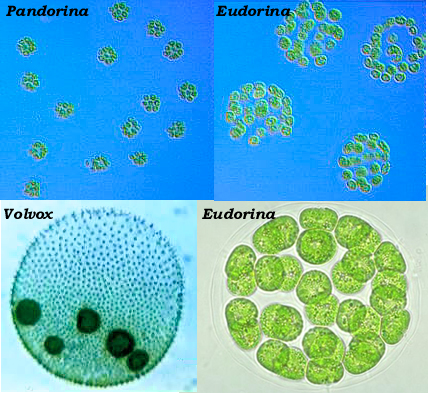
Some living things, like bacteria, are made of only one cell. Others, like human beings and trees, are made of many cells -may be billions of them- each cell doing a special job, all cells cooperating. But some living things are right on the borderline between those two categories. For instance, there's the whole order of green algae known as the volvocines. The microscope reveals that the basic cell of these algae is egg-shaped, with a couple of whiplike tails that it uses to swim around in water. The simplest volvocine algae are collections of just four of these cells, stuck together with a kind of jelly and arranged so their whiplike tails are all on the same side. The whole colony of four cell swims as a unit. There are other volvocines, with pretty names like Pandorina and Eudorina, made of 16, 32, or 64 cells that swim together as a unit, cooperating for the common good. The next step up in complexity is to add specialization to cooperation. There are colonies of 64 or 128 cells, so-called Pleodorina, for instance, in which only the cells on one side of the colony are capable of reproducing. The other cells help with swimming, but they can't reproduce. And most complex of all are the so-called Volvox colonies, made of thousands of cells connected to make a beautiful emerald-green hollow sphere that swims as a unit. Inside each Volvox sphere are a few large cells whose only function is to reproduce. Those special reproductive cells aren't even capable of swimming. The different kinds of volvocine algae, ranging from extreme simplicity to the beginnings of complexity, may be giving us a glimpse of how the first living things made of more than one cell evolved.

This text has been extracted
from How can you tell if a spider is dead? And more moments of science,
edited by Don Glass, Indiana University Press, 1996. It gives the following
two references:
Curtis, Helena. Biology.
4th ed. New york: Worth Pubs., 1983.
Gilbert, Scott F.
Developmental
Biology. 4th ed. Sunderland, Mass.: Sinauer Associates, 1994.
This page last updated 2000 Sep 23 by Enrique.